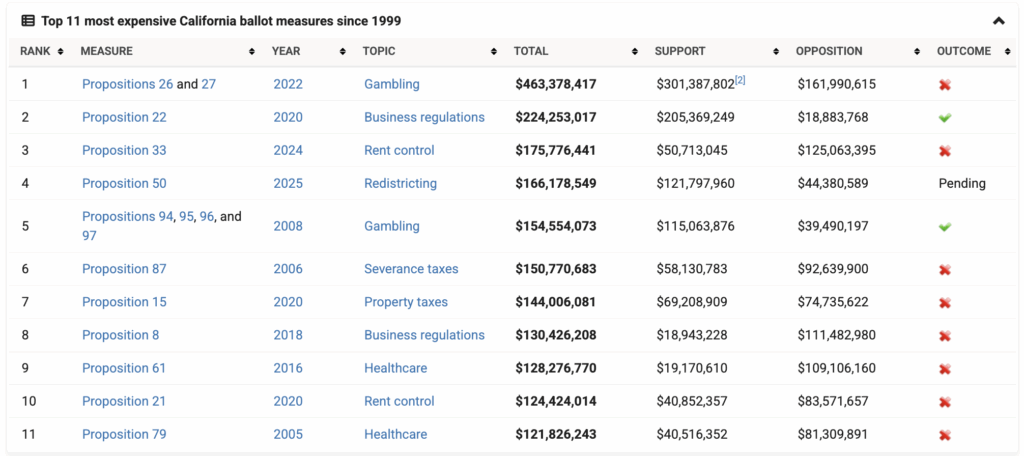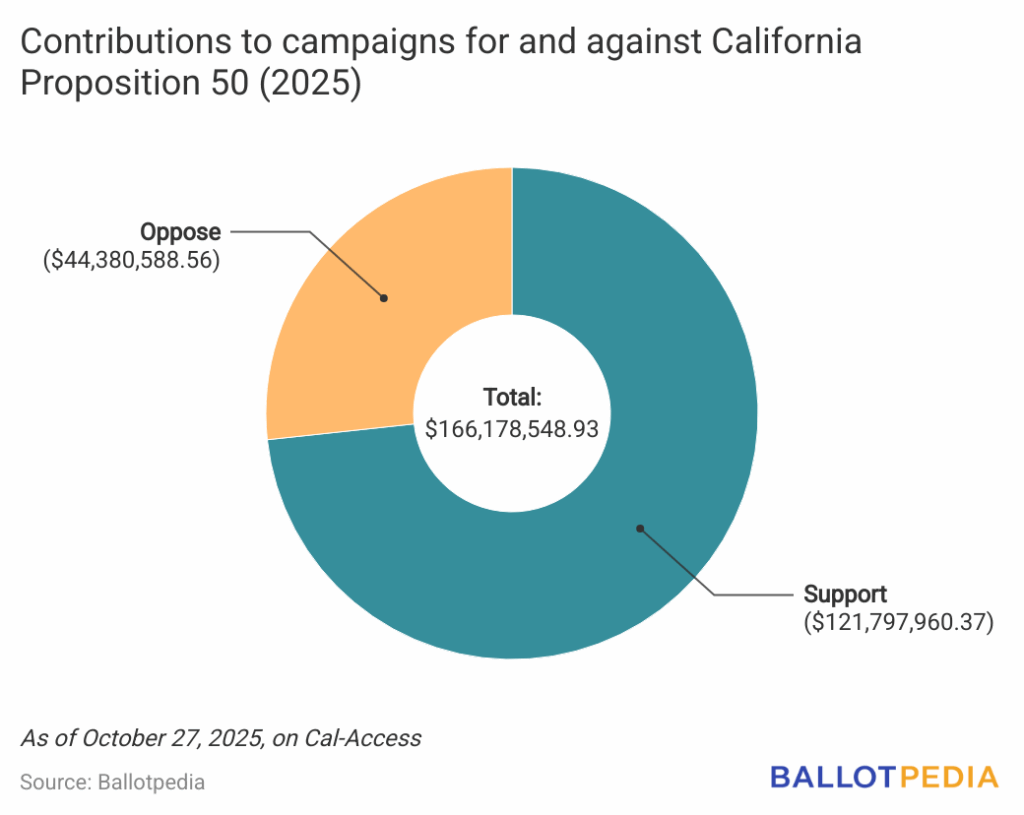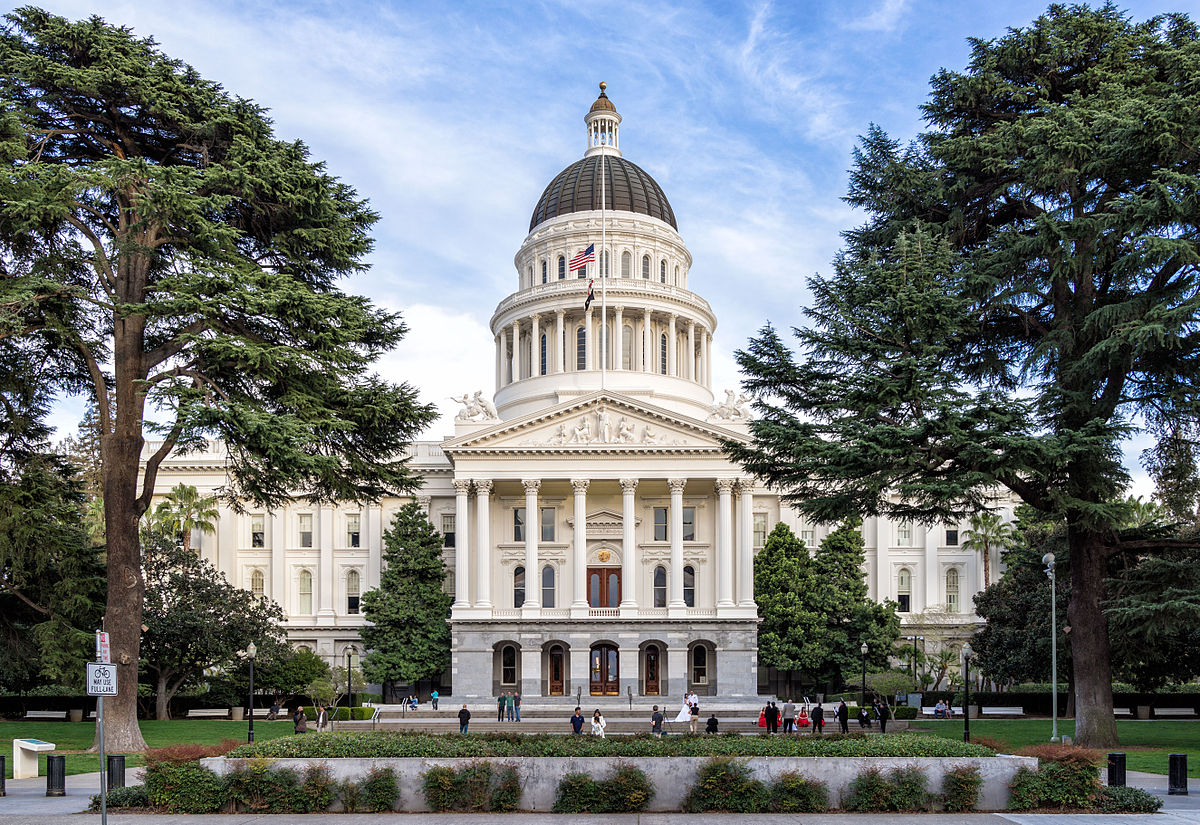California Proposition 50 is now the fourth most expensive ballot measure in the state’s history based on campaign contributions. Voters will decide the measure, which would authorize a new congressional districts map, at a special election on Nov. 4, 2025.
As of Oct. 27, committees supporting and opposing the measure had raised a combined $166.2 million. Supporters reported $121.8 million, while opponents reported $44.4 million.
Comparison to other most expensive measures in California
Proposition 50 is different from the other ballot measures on the top-10 list in at least two ways: its subject—redistricting—and its donor composition. Other measures on the list addressed issues such as gambling, taxation, business regulation, rent control, and healthcare. And, with those ballot measures, the largest share of funding on at least one side came from entities with some financial interest, such as businesses, trade associations, business-aligned PACs, or tribes with gambling interests. With Proposition 50, the largest donors on both sides include individuals, political committees, and nonprofits, with labor unions also accounting for large donations on the support side.
The following table shows the top 10 most expensive ballot measures in California history. Click here for more information.

Of the ten most expensive ballot measures, the side with the most contributions won in every election except the costliest, Propositions 26 and 27 (2022), which saw $463.3 million in contributions. Both ballot initiatives sought to legalize sports betting under different systems and had overlapping campaigns that spent against each other. Voters rejected both.
Support
Yes on 50, The Election Rigging Response Act, Governor Newsom’s Ballot Measure Committee is leading the campaign in support of Proposition 50. Twelve additional state-level political action committees (PACs) registered and reported contributions in support of the ballot measure.
As of Oct. 27, supporters received $121.8 million and spent $84.7 million.
The five largest donors to the support PACs were:
- The House Majority PAC (HMP), along with the associated HMP for Prop 50 PAC, contributed $16.4 million—13.5% of the campaign's total funds. HMP is a super PAC that focuses on electing Democrats to the U.S. House of Representatives
- The Fund for Policy Reform contributed $10.0 million. FPR is a 501(c)(4) associated with the Open Society Foundations, founded by George Soros. According to FPR's Form 990, the organization's mission is to support legislation that "assures greater fairness in political, legal and economic systems and safeguards fundamental rights."
- The California Teachers Association Issues PAC contributed $3.9 million.
- The California Nurses Association contributed $3.4 million.
- The National Education Association contributed $3.0 million.
Tom Steyer also made an independent expenditure of $12.8 million for advertisements supporting Proposition 50. Steyer is an investor, philanthropist, and donor to progressive and Democratic causes. He founded the organization NextGen America and ran for president in 2020. Steyer made the expenditure separate from the PACs supporting Proposition 50.
Based on regular campaign finance reports, which provide information through Oct. 18, the support PACs reported 108,359 unique donors, including 55,441 (51.2%) who are California residents. The average donation size was $951, and the median donation was $100.
Opposition
Two PACs—No on Prop 50 - Protect Voters First and No on Prop 50 - Stop Sacramento's Power Grab—are leading the campaigns opposing Proposition 50. Five additional state-level PACs registered and reported contributions in opposition to the ballot measure.
As of Oct. 27, opponents received $44.4 million and spent $41.9 million.
The five largest donors to the opposition PACs were:
- Charles T. Munger, Jr. contributed $32.7 million—73.9% of the opposition's total funds. Munger, a physicist and political donor, is the son of Charles Munger Sr., who was a business partner at Berkshire Hathaway. He was chairperson of the Santa Clara County Republican Party (2012-2015) and the California Republican Party's Initiatives Committee (2013-2019). He contributed to several ballot measure campaigns in the 2000s and 2010s, including campaigns to create the California Citizens Redistricting Commission
- The Congressional Leadership Fund contributed $5.0 million. The Congressional Leadership Fund is a super PAC that focuses on electing Republicans to the U.S. House of Representatives.
- The Kevin McCarthy for Congress PAC contributed $1.0 million. McCarthy served in the U.S. House of Representatives from 2007 to 2023, including as Speaker from Jan. to Oct. 2023
- Thomas M. Siebel, Chairman of C3.ai, Inc., contributed $1.0 million.
- Robert A. Kotick, former CEO of Activision Blizzard, contributed $990,000.
Based on regular campaign finance reports, which provide information through Oct. 18, the opposition PACs reported 419 unique donors, including 391 (93.3%) who are California residents. The average donation size was $104,512, and the median donation was $250.
The final regular campaign finance filing deadline before the election was Oct. 23, 2025, with the next scheduled for Feb. 2, 2026. However, campaigns must report contributions exceeding $1,000 within 24 hours during the 90 days preceding the election.

Additional reading:


